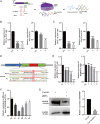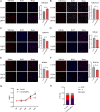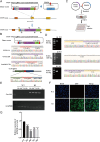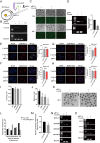CRISPR/Cas13d-mediated efficient KDM5B mRNA knockdown in porcine somatic cells and parthenogenetic embryos
- PMID: 34096883
- PMCID: PMC8284906
- DOI: 10.1530/REP-21-0053
CRISPR/Cas13d-mediated efficient KDM5B mRNA knockdown in porcine somatic cells and parthenogenetic embryos
Abstract
An efficient mRNA knockdown strategy is needed to explore gene function in cells and embryos, especially to understand the process of maternal mRNA decay during early embryo development. Cas13, a novel RNA-targeting CRISPR effector protein, could bind and cleave complementary single-strand RNA, which has been employed for mRNA knockdown in mouse and human cells and RNA-virus interference in plants. Cas13 has not yet been reported to be used in pigs. In the current study, we explored the feasibility of CRISPR/Cas13d-mediated endogenous RNA knockdown in pigs. KDM5B, a histone demethylase of H3K4me3, was downregulated at the transcriptional level by 50% with CRISPR/Cas13d in porcine fibroblast cells. Knockdown of KDM5B-induced H3K4me3 expression and decreased the abundance of H3K27me3, H3K9me3, H3K4ac, H4K8ac, and H4K12ac. These changes affected cell proliferation and cell cycle. Furthermore, stable integration of the CRISPR/Cas13d system into the porcine genome resulted in the continuous expression of Cas13d and persistent knockdown of KDM5B. Finally, the RNA-targeting potential of Cas13d was further validated in porcine parthenogenetic embryos. By microinjection of Cas13d mRNA and gRNA targeting KDM5B into porcine oocytes, the expression of KDM5B was downregulated, the abundance of H3K4me3 increased as expected, and the expression of embryonic development-related genes was changed accordingly. These results indicate that CRISPR/Cas13d provides an easily programmable platform for spatiotemporal transcriptional manipulation in pigs.
Conflict of interest statement
The authors declare that there is no conflict of interest that could be perceived as prejudicing the impartiality of the research reported.
Figures




Similar articles
-
Cas13d: A New Molecular Scissor for Transcriptome Engineering.Front Cell Dev Biol. 2022 Mar 31;10:866800. doi: 10.3389/fcell.2022.866800. eCollection 2022. Front Cell Dev Biol. 2022. PMID: 35433685 Free PMC article. Review.
-
Impairment of preimplantation porcine embryo development by histone demethylase KDM5B knockdown through disturbance of bivalent H3K4me3-H3K27me3 modifications.Biol Reprod. 2015 Mar;92(3):72. doi: 10.1095/biolreprod.114.122762. Epub 2015 Jan 21. Biol Reprod. 2015. PMID: 25609834 Free PMC article.
-
CRISPR-Cas13d Induces Efficient mRNA Knockdown in Animal Embryos.Dev Cell. 2020 Sep 28;54(6):805-817.e7. doi: 10.1016/j.devcel.2020.07.013. Epub 2020 Aug 7. Dev Cell. 2020. PMID: 32768421
-
Coordination of zygotic genome activation entry and exit by H3K4me3 and H3K27me3 in porcine early embryos.Genome Res. 2022 Aug 25;32(8):1487-1501. doi: 10.1101/gr.276207.121. Genome Res. 2022. PMID: 35868641 Free PMC article.
-
KDM5B is a master regulator of the H3K4-methylome in stem cells, development and cancer.Semin Cancer Biol. 2019 Aug;57:79-85. doi: 10.1016/j.semcancer.2018.11.001. Epub 2018 Nov 16. Semin Cancer Biol. 2019. PMID: 30448242 Free PMC article. Review.
Cited by
-
Applications of CRISPR/Cas13-Based RNA Editing in Plants.Cells. 2022 Aug 27;11(17):2665. doi: 10.3390/cells11172665. Cells. 2022. PMID: 36078073 Free PMC article. Review.
-
Ablation of OCT4 function in cattle embryos by double electroporation of CRISPR-Cas for DNA and RNA targeting (CRISPR-DART).PNAS Nexus. 2023 Oct 20;2(11):pgad343. doi: 10.1093/pnasnexus/pgad343. eCollection 2023 Nov. PNAS Nexus. 2023. PMID: 37954164 Free PMC article.
-
Critical role of Spatio-Temporally Regulated Maternal RNAs in Zebrafish Embryogenesis.bioRxiv [Preprint]. 2024 Nov 8:2024.11.07.622483. doi: 10.1101/2024.11.07.622483. bioRxiv. 2024. PMID: 39574587 Free PMC article. Preprint.
-
Massively parallel profiling of RNA-targeting CRISPR-Cas13d.Nat Commun. 2024 Jan 12;15(1):498. doi: 10.1038/s41467-024-44738-w. Nat Commun. 2024. PMID: 38216559 Free PMC article.
-
Cas13d: A New Molecular Scissor for Transcriptome Engineering.Front Cell Dev Biol. 2022 Mar 31;10:866800. doi: 10.3389/fcell.2022.866800. eCollection 2022. Front Cell Dev Biol. 2022. PMID: 35433685 Free PMC article. Review.
References
-
- Albert M, Schmitz SU, Kooistra SM, Malatesta M, Morales Torres C, Rekling JC, Johansen JV, Abarrategui I, Helin K. 2013. The histone demethylase Jarid1b ensures faithful mouse development by protecting developmental genes from aberrant H3K4me3. PLoS Genetics 9 e1003461. (10.1371/journal.pgen.1003461) - DOI - PMC - PubMed
Publication types
MeSH terms
Substances
LinkOut - more resources
Full Text Sources
Research Materials

